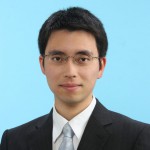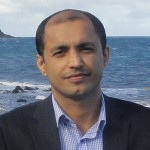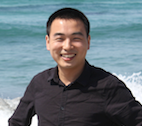| Sarit Agasti |
|
 |
Sarit received his Bachelor’s degree in Chemistry from the University of Calcutta, in 2003 and then his Master’s degree from the Indian Institute of Technology, Kanpur in 2005. Sarit went on to receive his PhD from the University of Massachusetts at Amherst under the supervision of Professor Vincent M. Rotello. Since his PhD, he has been a Postdoctoral Fellow at both the Massachusetts General hospital-Harvard Medical School and the Wyss Institute at Harvard University working with Professor Ralph Weissleder and Professor Peng Yin, respectively. Sarit has now returned to India and is working as a Faculty fellow at the Jawaharlal Nehru Centre for Advanced Scientific Research. His lab is interested in engineering small molecules and programmable molecular materials to address challenges in bioimaging, specifically in super-resolution microscopy. |
| Athina Anastasaki |
|
 |
Athina received her Bachelor’s degree in Chemistry from the National and Kapodistrian University of Athens. She then undertook a PhD in Polymer Chemistry at the University of Warwick under the supervision of Professor David Haddleton. She then undertook the position of a Monash-Warwick Alliance Research Fellow in the research groups of Professor David Haddleton and Professor Thomas Davis, focusing on controlled living radical polymerization methods, mechanistic studies, photochemistry and sequence-controlled polymers. Currently, she is an Elings Fellow working alongside Professor Hawker at the University of California, Santa Barbara (UCSB). |
| Maartje Bastings |
|
 |
Maartje Bastings studied Biomedical Engineering at the Eindhoven University of Technology (TU/e) and graduated Cum Laude in the group of Prof. E. W. (Bert) Meijer, where she continued her Ph.D. program funded by a Toptalent Fellowship from the Dutch Science Foundation (NWO). Her research focused on the understanding of multivalent binding mechanisms for directed targeting and the development of supramolecular biomaterials. She was awarded the University Academic Award in 2013 for best Ph.D. thesis at the TU/e. She moved to the Wyss Institute of Harvard University in Boston as a NWO Rubicon and Human Frontier Science Program postdoctoral fellow in the lab of Prof. William M. Shih. She studies DNA as a programmable biomaterial to design immune responses and assemble into multimodal nanoparticles. In January 2017 she will start as tenure track Assistant Professor in the Materials Science and Engineering Department at EPFL, Switzerland. |
|
|
| Thomas Bennett |
|
 |
Born in South Shields, in the North-East of England, in 1986. After attending Harton Comprehensive, and subsequently St. Josephs 6th Form, Tom read the Natural Sciences Tripos at the University of Cambridge. He chose to specialise in Chemistry, gaining a 1st class MSci (Hons) in 2008, before switching to the Materials Science and Metallurgy Department to study the physical properties of porous hybrid frameworks under Professor Anthony Cheetham. He has just completed 3 years as a Research Fellow at Trinity Hall, looking at the utility of structural collapse of hybrid frameworks and lecturing some of the 1B Materials Chemistry course at the department. He is the recipient of an EPSRC post-doctoral prize (2012) the Panalytical award for an outstanding contribution to X-ray diffraction (2013), a Research Fellowship at Trinity Hall, University of Cambridge (2013), a visiting adjunct professor position at The Wuhan University of Technology (2016) and a Royal Society University Research Fellowship, starting in 2016.
|
| Robert Chapman |
|
 |
Robert received his Bachelor’s degree from the University of New South Wales and then spent a year as an Associate Consultant for the Boston Consulting Group before returning to academia to complete his PhD at the University of Sydney under the supervision of Professors Sébastien Perrier and Katrina Jolliffe. Since his PhD, Robert has been based at Imperial College London as a Postdoctoral Research Associate working with Professor Molly Stevens on nanoparticle based biosensors and polymer scaffolds for tissue engineering. Robert is now a University of New South Wales Vice-Chancellor’s Post Doctorial Research Fellow, working in the School of Chemistry and the Centre for Advanced Macromolecular Design (CAMD). Robert uses enzymes to design multivalent polymer-peptide conjugates for protein binding applications and to design novel biosensors for the detection of disease. |
| Chaohua Cui |
|
 |
Dr. Chaohua Cui is currently an associate professor at Soochow University. He received his Bachelor’s degree from the Beijing Institute of technology in 2009 and then went on to receive his Master’s degree from the Beijing University of Chemical Technology in 2011. Chaohua completed his PhD in 2014 from Hong Kong Baptist University under the supervision of Professor Wai-Yeung Wong. His research focus is on developing novel conjugated polymer and small-molecule donor materials for organic solar cells. |
| Xiaoguang Duan |
|
 |
Dr. Xiaoguang Duan obtained his doctorate degree in Chemical Engineering from Curtin University, Australia, where he continued his research as a postdoctoral research fellow. His research interests focus on precisely tailoring structure/surface-chemistry of nanocarbons and metal crystals with state-of-the-art nano-engineering and advanced protocols. Moreover, he has been dedicated to seeking the feasible applications of advanced materials in new areas as well as probing the intrinsic active sites and reaction pathways for in-depth mechanistic studies. |
| Rebecca Gieseking |
|
 |
Rebecca received both her Bachelor’s and Master’s degrees from Furman University; she then went on to receive her PhD from the Georgia Institute of Technology under the supervision of Professor Jean-Luc Brédas. Rebecca is now a Postdoctoral fellow at Northwestern University working with Professors George Schatz and Mark Ratner researching photoinduced electron transfer in plasmonic systems. |
| Masayuki Gon |
|
 |
Masayuki Gon is an Assistant Professor at the Department of Polymer Chemistry of the Graduate School of Engineering at Kyoto University in Japan. He earned his PhD in Polymer Chemistry from Kyoto University in 2016, working with Prof. Yoshiki Chujo. He worked as a Visiting Research Fellow in Prof. Kenneth J. Wynne’s laboratory at the Virginia Commonwealth University in America, in 2014. In his thesis work, he developed three-dimensionally-arranged π-conjugated materials and studied their specific optical and physical properties based on the structure and chirality. His present research theme is development of functional π-conjugated materials with the unique nature of heteroatoms. |
| Jafar Hasan |
|
 |
Jafar Hasan is an Early Career Fellow of the Wellcome-Trust/DBT India Alliance in the Department of Materials Engineering at the Indian Institute of Science, Bangalore (India). He completed his PhD from Swinburne University of Technology, Melbourne (Australia) in 2013. This was followed by a period in a post-doctoral position at the Indian Institute of Technology, Bombay (India). He also has a Bachelor of Technology degree in Biotechnology from Uttar Pradesh Technical University, Lucknow (India). His current research focuses on nanostructured materials, bionanotechnology, biomaterials, microbiology and tissue engineering. |
| Lihua Jin |
|
 |
Lihua Jin is an Assistant Professor in the Department of Mechanical and Aerospace Engineering at the University of California, Los Angeles. She was a postdoctoral scholar at Stanford University working with Professor Zhenan Bao, Wei Cai and Christian Linder. In 2014, she obtained her PhD degree in Engineering Sciences from Harvard University under the supervision of Professor Zhigang Suo. Prior to that, she earned her Bachelor’s and Master’s degrees from Fudan University in 2006 and 2009. Lihua studies the mechanics of soft materials. Her current research topics include mechanical instabilities of soft materials, constitutive modeling of stimuli-responsive materials, and designing of soft robots and stretchable electronics. |
| Seong-Min Jo |
|
 |
Seong-Min Jo was born in South Korea, and he finished his academic programs there. He specialised in biomaterials engineering, studing at the Kangwon National University. He received his doctoral degree at the Korea Advanced Institute of Science and Technology (KAIST) in August 2014, where he studied biosensors for cancer diagnosis. Since June 2015, he has started his postdoctoral career in Prof. Dr. Katharina Landfester’s group at the Max Planck Institute for Polymer Research in Mainz in Germany. His research focuses on designing artificial cells, which are unique systems that mimic cell-like features by combining biomolecular, polymeric and inorganic materials. |
| Gregor Kieslich |
|
 |
Gregor Kieslich is an inorganic chemist focusing on crystal chemistry and structure–property relations in functional solids and hybrid frameworks. He studied chemistry between 2006 and 2010 at the Johannes Gutenberg University in Mainz. After completing his PhD in 2013 with Prof. W. Tremel, he moved to Cambridge University to work with Prof A. K. Cheetham. Throughout his career he has been awarded several fellowships, including the Konrad-Adenauer PhD fellowship and the DFG research fellowship. Currently, he is a Junior Research Group leader at the Technical University of Munich, holding a Liebig-Fellowship. |
| Peter Korevaar |
|
 |
Peter received both his Bachelor’s and Master’s degree from Eindhoven University of Technology before also completing his PhD at Eindhoven University of Technology under the supervision of Professor E. W. Meijer in 2014. Since his PhD Peter has been a Postdoctoral researcher at both Eindhoven University of Technology and more recently at Harvard University working with Professor J. Aizenberg researching the development of adaptive materials. |
| Vipin Kumar |
 |
Dr. Vipin Kumar obtained his Ph.D degree from school of materials science and engineering, Nanyang Technological University (NTU) Singapore with a Ph.D thesis entitled “Structural-chemistry of Molybdenum oxide and its derivatives and their Application in Supercapacitors”. Before joining NTU Singapore, Dr. Kumar was at the Indian Institute of Technology (IIT) Delhi, New Delhi, India, where he obtained his master degree in Solid-state Materials. His research mainly focuses on local and global electrochemical properties of nanomaterials, including metal-organic-framework (MOF), two-dimensional (2D) and one-dimensional (1D) transition metal oxides. Recently, he has widened the research area, and focusing on the sensing behavior of metal-oxide nanowires in toxic and flammable gases atmosphere. Most recently, he started working on the detection of volatile organic compounds (VOCs) using 2D nanomaterials (MXenes and graphene oxide) as the sensing platform. |
| Ester Kwon |
|
 |
Ester received a B.S. in Bioengineering and a B.A. in Molecule & Cell Biology from UC Berkeley in 2004 and a Ph.D. in Bioengineering from the University of Washington at Seattle in 2010. She completed her doctoral work in the laboratory of Dr. Suzie Pun developing nucleic acid delivery vehicles decorated with peptides to mediate targeting and endosomal escape for applications to the central nervous system. In the Bhatia group, Ester is interested in understanding how nanoscale materials interact with host biology. She develops diagnostic and therapeutic nanosystems in animal models of ovarian cancer, bacterial pneumonia, and traumatic brain injuries. |
| Taehun Lee |
|
 |
Taehun Lee received a B.S. degree in the Dept. of Material Science and Engineering from Yonsei University, South Korea in 2011. He is pursuing his Ph. D. degree under the supervision of Prof. Aloysius Soon in the same department. His research interests include the applications of density-functional theory (DFT) calculations, exploiting atomic scale advanced thermodynamics to understand metals or oxides material properties in the field of theoretical surface and interface science. |
| Ting Lei |
|
 |
Ting received his Bachelor’s degree in Chemistry from Peking University in 2008. He continued his study with Prof. Jian Pei in Peking University and obtained his PhD in 2013, where he was working on organic/polymer electronic materials. Ting is currently a postdoctoral associate in Prof. Zhenan Bao’s group at Stanford University, focusing on the development of polymer and carbon based electronics. |
| David Lunn |
|
 |
David grew up in Berkhamsted, a small town north of London, UK. He attended the University of Bristol for both his MSci and PhD. The latter as one of the first cohort of the Bristol Chemical Synthesis Centre for Doctoral Training, supervised by Prof. Ian Manners and Prof. Paul Pringle. David is currently a Marie Curie Global Fellow between the groups of Prof. Hagan Bayley, University of Oxford, and Prof. Craig Hawker, University of California, Santa Barbara. His research experience is broad, covering chemical synthesis, polymers and materials science, with a current focus on the 3D-printing of artificial tissue-like materials. |
| Tian-Yi Ma |
|
 |
Tian-Yi received both his Bachelor’s degree and PhD from Nankai University in 2008 and 2013, respectively. Since 2013 Tian-Yi has been at the University of Adelaide in the School of Chemical Engineering, as an Australian Research Council Discovery Early Career Researcher Award (ARC DECRA) fellow, developing high-performance electrocatalysts in metal-air batteries and water splitting devices on the basis of organic polymer, carbon, transition-metal, metal-organic framework materials. |
| Jaime Martín Perez |
|
 |
Jaime received his Bachelor’s degree in 2005 from the University of the Basque Country before receiving his PhD from the Institute of Polymer Science, Spanish National Research Council (CSIC) in 2010. Since his PhD, Jaime he was a research associate at both the National Centre for Microelectronics, CSIC and Imperial College London, where he is now a Maria Sklodowska-Curie Individual Fellow working on confinement effects in polymer materials and solution processing of organic photonic crystals. |
| Kosuke Minami |
|
 |
Dr. Kosuke Minami received his B.Sc. from the University of Tokyo in 2008, majoring in biology. He obtained his Ph.D. in chemistry under the guidance of Prof. Eiichi Nakamura from the University of Tokyo in collaboration with Prof. Eisei Noiri at Faculty of Medicine, the University of Tokyo in 2013. He started his work as a postdoctoral fellow at World Premier International (WPI) Research Center for Materials Nanoarchitectonics (MANA) in National Institute for Materials Science (NIMS) from 2013 and became YAMATO-MANA (Young, Aspiring Motherland Academics To MANA) scientist in 2014. His research interests lie in the interdisciplinary field of chemistry and biology, especially the fields of synthetic organic chemistry, supramolecular chemistry, material chemistry and molecular biology, including drug delivery systems and tissue engineering. His research currently focuses on synthesis of functionalized nano-carbons and biological application of nano-carbon assembly. |
| Markus Müllner |
|
 |
Markus received his PhD in polymer chemistry from the University of Bayreuth in Germany in 2012. He subsequently joined the University of Melbourne in Australia as a Postdoctoral Research Fellow (2012-15). Currently, he is a Lecturer in the School of Chemistry at The University of Sydney in Australia. His research at the Key Centre for Polymers and Colloids bridges polymer and materials science and emphasises on the design of elaborate polymeric architectures which can be used to produce hybrid materials, sensors or multifunctional nanomedicines. |
| Wee-Jun Ong |
|
 |
Dr. Wee-Jun Ong received his BEng and Ph.D. degrees in Chemical Engineering from Monash University in 2012 and 2016, respectively. He is presently a Research Scientist in Institute of Materials Research and Engineering (IMRE), Agency for Science, Technology and Research (A*STAR), Singapore. He was the recipient of the “Excellence Scholarship Award 2014–2016” and “Endeavour Research Fellowship 2015” by the Department of Education (Australia). In 2015, he was a Visiting Research Fellow in University of New South Wales and Monash University Australia. He received the “David Trimm Catalysis Award 2015” in recognition of his photocatalysis work. His research interests include the development of carbonaceous and two dimensional-based nanocomposites for energy conversion, storage and environmental remediation. He is the finalist for ‘Young Researcher Award 2016’ by IChemE. |
| Christopher Proctor |
|
 |
Christopher Proctor is a postdoctoral researcher and Whitaker International Scholar at the Ecole des Mines de St. Etienne in France. He received his B.Sc. from the University of Michigan (2008) and worked at the U.S. Nuclear Regulatory Commission before earning his Ph.D. in materials at the University of California, Santa Barbara (2015). His research has been recognized with awards from the Materials Research Society and fellowships from the Frenkel Foundation and the US National Science Foundation. His research interests include energy harvesting and bioelectronics. |
| M. Tariq Sajjad |
|
 |
M. Tariq Sajjad received his M.Sc in Nanotechnology and nanoelectronic devices and his PhD, both from the Advanced Technology Institute at the University of Surrey, UK. His PhD was focussed on Exciton Dynamics in carbon nanotubes, where he studied exciton diffusion and exciton-exciton annihilation in carbon nanotubes. After his PhD, he moved to University of St Andrews, to work as a researcher as well as coordinator of two centres (Organic Semiconductor Centre and Advanced Functional Materials Research Centre). The central theme of his research is to investigate and understand the optical and photophysical properties of optoelectronic materials for their possible applications in solar cells, light emitting devices and visible light communication. |
| Troy Townsend |
|
 |
Troy received his Bachelor’s in Chemistry and Biology from St Mary’s College of Maryland; he then spent a year as a High School Chemistry teacher before completing his PhD in Inorganic Chemistry under the supervision of Professor Frank Osterloh in 2012. Troy spent two years as a Postdoctoral fellow at the US Naval Research Laboratory before returning to St Mary’s College of Maryland as a visiting Assistant Professor of Chemistry as well as researching solution processing of nanocrystal electronics. |
| Daiki Umeyama |
|
 |
Daiki received his Bachelor’s and Master’s degree, as well as his PhD, from Kyoto University. Since the completion of his PhD in early 2015 he has been working as a Postdoctoral research fellow at Stanford University investigating functional properties of halide hybrid perovskites. |
| Mengye Wang |
|
 |
Mengye received both her Bachelor’s degree and PhD from Xiamen University under the supervision of Professor Changjian Lin. She was also a visiting PhD student at the Georgia Institute of Technology working under the supervision of Professor Zhiqun Lin, completing her PhD in early 2015. She is now researching advanced nano-materials for energy related application at Xiamen University. |
| Chao Wang |
|
 |
Dr. Chao Wang obtained his B.E. in Chemical Engineering in 2007. Then he received his Ph.D. in Chemistry from Tsinghua University in 2011 under the supervision of Prof. Xi Zhang. Dr. Wang’s Ph.D. thesis, which focuses on self-assembled smart soft materials, won National Excellent Doctoral Dissertation Award of China in 2013. Subsequently he joined Prof. Zhenan Bao’s group in Stanford University as a postdoctoral scholar, where he introduced self-healing chemistry, a concept derived from supramolecular chemistry, to the group and developed self-healing electronics and energy storage devices. In 2014, he was awarded ‘MRS Postdoctoral Award’. In 2015, Dr. Chao Wang joined University of California Riverside as an Assistant Professor of Chemistry, focusing on the research of mechanically adaptive functional materials. |
| Hongbin Yao |
|
 |
Hongbin Yao was born in 1983 in Chongqing, China. He obtained the B.S. degree from University of Science and Technology of China (USTC) in 2006 and received PhD degree from Hefei National Laboratory for Physical Sciences at the Microscale in 2011 under the supervision of Prof. Shu-Hong Yu. He worked in Prof. Yi Cui’s group at Stanford University as a Postdoc from 2012 to 2015. After the postdoctoral experience, he joined the faculty of USTC in 2015. His interest is in the development of light and strong bio-inspired materials and high energy density lithium metal based batteries. |
| Hamish Yeung |
|
 |
Hamish Yeung is a Glasstone Research Fellow in Inorganic Chemistry at the University of Oxford. He studied Natural Sciences at Cambridge University (2008), where he stayed to pursue a PhD (2012) and postdoctoral research with Tony Cheetham. From 2014 until 2016 he held an independent research position in the International Center for Young Scientists (ICYS) at the National Institute for Materials Science (NIMS), Japan. His research interests include the crystallization and phase behaviour of hybrid materials, and using in-situ crystallography to probe functional materials under external stimuli. Outside of the laboratory he enjoys synthesis of edible materials and all things outdoors. |
| Nan Zhang |
|
 |
Nan Zhang received her Ph.D. degree with the supervision of Prof. Yi-Jun Xu at State Key Laboratory of Photocatalysis on Energy and Environment, Fuzhou University, P.R. China in 2016. She is currently working as a research fellow in Prof. Ghim Wei Ho’s group at National University of Singapore. Her main research interests include the fabrication of core-shell and carbon-based composites for potential target applications in heterogeneous photocatalysis. |











































